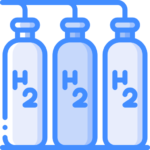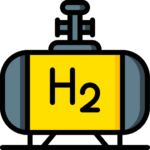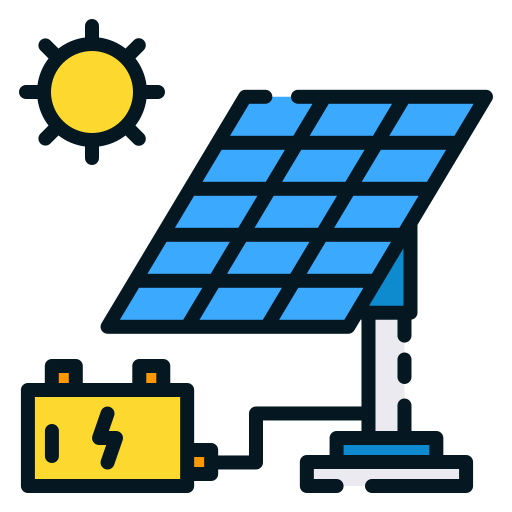![]()
Air pollution represents a major environmental health risk. The air quality index is a figure provided by the authorities in an area that reflects the amounts of pollutants detected in the air. The European Environment Agency provides the air quality index for citizens to check the air quality in any city or region in Europe, which takes into account four pollutants harmful to human health and the environment: particulate matter (PM), ozone (O3), nitrogen dioxide (NO2) and sulphur dioxide (SO2).
Alternative fuels are fuels that are presented as an option to traditional fossil fuels. They are obtained from renewable sources or from waste. Examples include hydrogen, methane and non-fossil natural gas, vegetable oil, propane, biomass and chemically stored electricity (batteries and fuel cells).

This is obtained in a similar way to grey hydrogen, but in this case the CO2 is captured after its production, instead of being released into the atmosphere, and is subsequently managed so as to have the least possible impact on the environment. As a result, blue hydrogen production is considered a low-carbon process.
Biodiversity is the shortened form of two words “biological” and “diversity”. It refers to all variety of life that can be found on Earth (plants, animals, fungi and microorganisms) as well as the communities they form and the habitats they live in.
A sustainable and circular economic model based on the knowledge and use of biological resources, processes and methods to provide goods and services in a sustainable manner in all economic sectors.
Bioenergy is a type of renewable energy that is derived from biological sources. It is a natural, high-quality energy resource, of organic, vegetable or animal origin, transformed by natural or industrial processes.
Biogas is the gas obtained from the anaerobic decomposition of organic matter present in municipal solid waste, wastewater and agricultural, livestock or forestry waste. It is a renewable, local and storable source of energy supply, with a positive impact on employment and the rural economy. After cleaning and separation of CO2, biogas is converted into biomethane, a fully renewable gas suitable for transmission by gas pipelines.
![]()
Liquefied natural biogas is a renewable fuel with zero net carbon emissions. Its use in transportation would neutralise CO 2 emissions. It is currently the most cost-effective and fastest way to achieve the goal of decarbonising transportation.
![]()
Biomass is organic matter that comes from plants and animals. It is a renewable energy source. The sun provides energy to biomass. Plants absorb energy from the sun in a process called photosynthesis. When biomass is burned, its chemical energy is released as heat. Today we have four types of biomass: wood and agricultural products, solid waste, landfill gas and biogas, and alcohol fuels (such as ethanol or biodiesel).
![]()
Biomethane is the renewable green energy obtained from cleaning (upgrading) biogas. Its use is already a reality in injection into the gas pipeline network, as a vehicle fuel or for use in industry. It is a gas formed mainly by methane and CO2.
![]()
LNG bunkering is the process of supplying liquefied natural gas for use as a transport fuel for ships. Bunkering operations are carried out at seaports and include the storage of fuels at bunker stations and LNG terminals and the supply of fuel to ships via different modes:
• Truck-to-Ship (TtS) bunkering: supplying fuel to a ship from a tanker truck. This is the most commonly used method. There is even Multi Truck-to-Ship (MTTS) bunkering to deliver more fuel in a shorter time.
• Ship-to-Ship (StS) bunkering: supplying fuel to a ship directly from a gas barge.
• Pipe-to-Ship (PtS) or Terminal-to-Ship bunkering: supplying fuel to a ship from a regasification plant or bunker station.
The carbon footprint is an environmental indicator that reflects the total amount of greenhouse gases (GHG) emitted directly or indirectly by an individual, organisation, event or product. It is measured in terms of mass of CO2 equivalent and enables the amount of GHGs released into the atmosphere as a result of any activity to be identified.
Carbon neutrality involves accounting for and reducing CO2 emissions throughout the value chain and offsetting unavoidable emissions with natural carbon sinks and/or carbon credits (zero or neutral balance).
Carbon dioxide (CO2) is a colourless, odourless gas with a density of approximately 1.5 times that of air. It is a carbon atom with a double covalent bond to two oxygen atoms. It is soluble in water and can therefore be naturally found in groundwater, rivers and lakes, ice caps, glaciers and seawater. It is present in oil and natural gas deposits. Since the industrial revolution, the atmospheric concentration of this gas has increased significantly, aggravating global warming. Solutions are currently being studied to capture it and store it in geological formations, or convert it into products of interest in order to reduce emissions.
A carbon policy is a set of measures aimed at reducing -to the point of elimination- greenhouse gas emissions into the atmosphere, with the goal of achieving carbon neutrality (a state of zero net emissions of carbon dioxide into the atmosphere).
According to Forética, this is the economic model that differs from the traditional linear model – for a model that is regenerative by design. The goal is to retain the highest possible value of resources, products, parts and materials to create a system that allows for longevity, optimal reuse, conditioning, remanufacturing and recycling. Companies implementing the circular economy focus on rethinking products and services using principles based on durability, renovation, reuse, repair, replacement, upgrading, conditioning and reduced use of materials. By applying these principles, companies can design waste management, increase resource productivity and decouple growth from the consumption of natural resources.
The energy that is obtained without generating waste or by-products that are harmful to the environment, that is to say, its production causes no damage or threat to our planet.

Climate change is the variation of the Earth’s climate.
The main cause of climate change is global warming, which is caused by emissions of greenhouse gases into the atmosphere after more than a century and a half of large-scale industrialisation, deforestation and farming.
Scientists have found that the Earth’s surface is warming, and many of the warmest years on record have been in the last 20 years.
The effects of climate change include extreme weather events, desertification, flooding due to rising sea levels, species extinction and mass migration.
There are international agreements to tackle climate change such as the Kyoto Protocol and the Conference of the Parties (COP).
Cogeneration is a highly efficient technology for the simultaneous generation of heat and power. Using one fuel to generate both heat and electricity at the same time in a single unit is more efficient and cost-effective than generating heat and electricity separately in two different units.
According to the Intergovernmental Panel on Climate Change, decarbonisation is the process in which countries or other entities endeavour to achieve a low-carbon economy, or through which people seek to reduce their carbon consumption.
In reference to one of the different taxes that are levied in order to indirectly contribute to the care of the environment.
Electrical energy is energy generated by the movement of electrical charges (electrons) inside conductive materials, such as a copper electrical cable. Electricity is the most widely used form of energy today. The electricity we use is a secondary energy source because it is obtained by converting primary energy sources such as coal, natural gas, nuclear energy, solar energy and wind energy into electrical energy.
Electrolysis is a chemical process in which the action of a continuous electrical current causes a substance or a body immersed in a solution to break down. We use electrolysis to obtain oxygen and hydrogen from water. But it has many different applications. For example, it is used to produce hydrogen and has multiple uses as a fuel or for industrial applications. It is also used to produce aluminium, sodium, potassium, magnesium, etc.
An electrolyser is a device that produces continuous electrical currents for electrolysis.
Emissions are gaseous fluids (pure or with substances held in suspension), radioactive,
electromagnetic or sound energy, which emanate as waste or as a result of human or natural activity.
Energy is the ability of a system to perform work, movement or transformation, and in which something is converted. In the International System of Units, energy is measured in joules (J) although other units such as calories (cal) or kilowatt hours (KWh) are also used.
Energy efficiency refers to the efficient use of energy. A device or installation is more energy efficient the less energy it consumes to perform an activity. An efficient person, service or product requires less energy to perform the same work.
Energy infrastructure refers to facilities which are capable of directing and managing the flow of energy and transporting it from the producer to the consumer.
A model based on isolation of the energy distribution network, with reliance on self-sufficiency in the generation, consumption and storage of energy.
It’s the combination of different energy sources that provide the energy supply of a specific geographical area, be it a country, a continent or a region.

It’s the combination of different energy sources that provide the energy supply of a specific geographical area, be it a country, a continent or a region.
The International Energy Agency defines energy security as the uninterrupted availability of energy sources at an affordable price. Energy security has many aspects: long-term energy security mainly deals with timely investments to supply energy in line with economic developments and environmental needs. On the other hand, short-term energy security focuses on the ability of the energy system to react promptly to sudden changes in the supply-demand balance.
Energy sources are those natural resources from which human beings can obtain the energy they subsequently use for their activities.
An energy system is a system that is primarily designed to provide energy services to end users.
Energy storage is the process by which we conserve surplus energy generated. The energy is stored for the purpose of releasing it and using it when required at a later date. This is essential to provide the energy system with flexibility, particularly when it comes to renewable energies (electricity), whose production peaks do not coincide with those of demand. There are different methods for storing energy: batteries, capacitors and hydrogen, among others, which can be applied on a large scale or at end-user level.
According to the World Energy Council, energy sustainability is the balance between three main dimensions: energy security, social equity, and the mitigation of environmental impact. The idea is to bring the concept of sustainable balance between the economic, social and environmental dimensions to the energy level, recognising that energy is key and basic for the development of any society.
The development of stable, accessible and environmentally sustainable energy systems requires complex interconnections between the public and private sectors, governments and regulators, the economy, available resources, legal regulations, environmental concerns and the individual and collective behaviour of societies.
The energy transition refers to the evolution of the economy towards parameters compatible with environmental limits. It is a term that refers to the path that countries must take in order to comply with an objective: the decarbonisation of the economy to ensure the achievement of the commitments made to the EU and in the Paris Agreement.
An energy vector is considered to be a substance or device capable of storing energy that can subsequently be released in a controlled manner. Batteries, cells and condensers are examples of energy vectors. As are electricity and hydrogen, which is currently presented as the energy vector of the future to achieve total decarbonisation.
It is the space in which a series of physical, chemical and biological elements operate, including all living and non-living beings and their interrelationship. It is the area conditioned for the life of different organisms.
Measurement of the environmental impact caused by a product or service throughout its life cycle, i.e. before, during and after cessation of the activity.
![]()
Measurement of the environmental impact caused by a product or service throughout its life cycle, i.e. before, during and after cessation of the activity.
![]()
The EU taxonomy is a new regulation that forms the pillar of the EU Sustainable Finance Action Plan. Its aim is to create a common language and uniform criteria to identify the extent to which economic activities can be considered environmentally sustainable.
A fuel cell is an electrochemical device that directly converts chemical energy into electrical energy by means of a controlled chemical reaction. It converts the chemical energy of a fuel, e.g. hydrogen, and an oxidant, oxygen, into electricity. Energy is released inside the fuel cell.
This term is used to describe the long-term increase in the Earth’s average temperature, a process that has been taking place on our planet for over a century and which could have various consequences for the development of life on Earth. Global warming is caused by both natural and man-made factors.
Renewable hydrogen or green hydrogen is produced by electrolysis of water from renewable electric energy, such as solar or wind. This process does not emit CO2 and transforms water into hydrogen and oxygen molecules. Thus, it is an effective solution for promoting the decarbonisation of all sectors (mobility, industry and service sector). The major advantage of green hydrogen is that it allows the decarbonisation of non-electrifiable sectors, opening the door to carbon neutrality. It can be used as a molecule (fuel in industry, etc.), and not only as an electric current, while renewable electric energies cannot cover all these needs.
Progressive increase in temperature that occurs because there is an excess of solar radiation on the earth’s surface and in the lower layers of the atmosphere, which, unable to escape, remains trapped in the atmosphere.
Greenhouse gases are naturally present on the planet. But human action increases their concentration. These gases undergo minor fluctuations, which cause variations in temperature that significantly affect the balance of ecosystems.
We call this the greenhouse effect because the atmosphere acts as a greenhouse for the Earth, letting in light, but retaining heat.
Greenhouse gases, originated by natural causes and by human action, are gases that are part of the atmosphere. They retain part of the earth’s heat after being warmed by the sun to keep the temperature of our planet at a level which is adequate to sustain life. The main greenhouse gases are water vapour, carbon dioxide, nitrogen oxide, methane and ozone.
Energy-economic model that consists of competitively producing green hydrogenfor use as an alternative to fossil fuels.

This is produced from fossil fuels, such as oil or natural gas, through a process known as natural gas steam reforming. The process produces CO2 that is released into the atmosphere, which means it is not an emission-free process. Currently, most of the hydrogen produced and used, especially in chemical processes, is grey hydrogen.
Hydrogen is the first element in the periodic table and the lightest in existence. Its atom is formed by a proton and an electron and is stable in the form of a diatomic molecule (H2). Under normal conditions it is in a gaseous state, and is tasteless, colourless and odourless.
It is the most abundant element on Earth. It constitutes approximately 75% of matter in the Universe, but it is combined with other elements such as oxygen, to form water molecules, or carbon, forming organic compounds. It is not, therefore, a fuel that can be taken directly from nature, but it is an energy vector (like electricity).

The “Hydrogen Roadmap: a commitment to renewable hydrogen” is the document approved by the Council of Ministers to promote the deployment of this sustainable energy vector, which will be key for Spain to achieve climate neutrality, with a 100% renewable electricity system, by 2050 at the latest.
Hydrogen stations are refuelling stations that supply hydrogen to hydrogen-fuelled vehicles. Spain currently has six hydrogen stations, located in Madrid, Seville, Zaragoza, Huesca, Albacete and Puertollano, although they are not for public use. The Hydrogen Roadmap approved by the Spanish Government provides for the implementation of a network with a minimum of 100 hydrogen stations by 2030.

This refers to an ecosystem that encompasses the entire hydrogen value chain, from production to consumption. It comprises communities in which industries, companies and individuals participate. Spain has some hydrogen valleys, such as the Hydrogen Valley of Catalonia, the Basque Hydrogen Corridor and Green Hysland on the island of Mallorca, the first hydrogen valley on a European island.
![]()
The Just Transition Strategy is one of the three pillars of the Strategic Energy and Climate Framework approved by the Spanish Government in 2019. It aims to optimise the employment outcomes of the Ecological Transition and to ensure that people and regions make the most of the opportunities of this transition and that no one is left behind.
The Just Transition Strategy includes different measures and instruments. Focusing on the decarbonisation process, the Strategy includes the Urgent Action Plan for Coal-mining Regions and Power Plant Closures between 2019-2021, which aims to respond to the closure of mining operations, coal-fired power stations and nuclear plants.
The Just Transition Agreements were created to achieve this objective, and apply to territories where closures could cause problems for businesses and economic activity.
These Agreements aim to maintain employment and the creation of activity in these territories by supporting sectors and groups at risk, encouraging the population to stay, and promoting diversification and specialisation consistent with the socio-economic context.
Liquefied natural gas (LNG) is liquid natural gas cooled to a temperature of approximately -160ºC for transport and storage. The volume of natural gas in the liquid state is approximately 600 times less than in the gaseous state.
These greenhouse gases are the main cause of global warming. There is a commitment backed by more than 100 countries to reduce them by 30% by 2030.
The stock of renewable and non-renewable resources provided by nature (plants, animals, minerals, water, etc.) from which we can produce goods and services.
Natural gas is one of the cleanest and most environmentally friendly fossil fuels, as it contains less carbon dioxide and has the lowest carbon emissions. It is also an economical and efficient energy source. It is a safe and versatile alternative capable of meeting energy demand in the domestic, commercial and industrial sectors.
They are goods and services that are created by nature without any human intervention and are beneficial to the well-being and development of society. These resources can be renewable or non-renewable.
NOx refers to a group of gases containing nitrogen and oxygen in various proportions, nitrogen dioxide (NO2), nitric oxide (NO) etc. They are highly reactive compounds. Vehicles, industry and other sectors involved in the burning of fossil fuels are currently the main sources of NOx emissions. Nitrogen oxides contribute to the formation of photochemical ozone (smog) in the atmosphere, thus contributing to global warming, and can also cause acid rain and have harmful consequences for health.
Energy sources are grouped into two types: renewable and non-renewable. Non-renewable energy sources are those that come from limited natural resources, such as fossil fuels.
![]()
The Paris Agreement is an international alliance on climate change that aims to establish measures to reduce greenhouse gas emissions and limit global temperature increases. 190 countries have joined since 2015.
![]()
PERTE is the Spanish acronym for ‘Strategic Project for the Recovery and Economic Transformation’ and is a public-private partnership programme aimed at improving economic growth, employment and the competitiveness of the Spanish economy. Among the programmes approved in 2021, the PERTE programme for renewable energies, renewable hydrogen and storage stands out, and consists of various measures to promote and consolidate these sectors, in which Spain is well positioned.
![]()
It is a novel technology that allows the production of green hydrogen, 100% renewable, from solar energy through a direct process without external electrical energy input (bias-free process). In photoelectrocatalytic systems, the sun’s energy is used directly to carry out the electrolysis process, i.e. it is the photons that provide the energy necessary to carry out the electrochemical reactions of water decomposition into hydrogen and oxygen.
This technology has competitive advantages over conventional electrolysis systems, mainly in terms of efficiency and hydrogen production costs, as it integrates the two processes: energy generation and transformation of energy into hydrogen in the same device.
![]()
Pink hydrogen is generated through the electrolysis of water from nuclear energy. It is considered to be a fairly sustainable type of hydrogen.
We call primary energy a form of energy found in nature that does not undergo any human-designed conversion process. Examples of primary energy are oil, natural gas, coal, biomass, running water, wind or solar radiation. In other words, fuels that can be mined, harvested, extracted, or exploited directly.
Primary energy sources are natural resources that are obtained directly from nature and that do not need transforming or converting.
Renewable energy is a type of energy that can be obtained from virtually inexhaustible natural sources, as they contain an immense amount of energy or can be regenerated naturally. The sun, wind, waterfalls and biomass are examples of renewable energy sources.
The ozone layer is a layer of gas in the upper atmosphere. The ozone layer acts as a filter and protects humans and other living things from the sun’s harmful ultraviolet (UV) rays. It is 10-20 km thick and envelops the entire planet like a bubble.
These are combustible gases that are considered neutral in terms of CO2 emissions. They are produced from the decomposition of organic matter present in municipal solid waste, wastewater and agricultural, livestock or forestry waste (e.g. biomethane); or from water electrolysis using renewable energies (e.g. green hydrogen). The term renewable gas generally refers to biogas, biomethane, green hydrogen and synthetic natural gas (SNG).

The United Nations’ Sustainable Development Goals represent the most ambitious action plan for people, the planet and prosperity for 2030. They are composed of 17 goals related to the major challenges faced by humanity.
The UN presents these 17 Sustainable Development Goals as “the master plan for a sustainable future for all”. The 17 goals have been included in the 2030 Agenda, given the vital importance of overcoming each and every one of them before that date (2030).
This agenda places business alongside states and civil society as agents of development and provides a universal and coherent framework to guide their contributions to sustainability and the creation of shared value.
Secondary energy refers to those energy resources that are converted or stored, and
that cannot be used directly from nature. Some examples of secondary energy are electricity, biodiesel, bioethanol, charcoal, coal coke, petroleum coke, diesel, etc.

Solar energy is obtained from the solar radiation that reaches the earth in the form of light, heat or ultraviolet rays. It is a clean and renewable energy, as the sun is an unlimited resource. There are three ways of harnessing solar energy: photovoltaic solar energy, which transforms sunlight into electrical energy; thermal solar energy, which captures radiation through elements called collectors or concentrators; and passive solar energy, which consists of adapting a building so that it can use solar energy for heating or cooling.
Energy sources are grouped into two types: renewable and non-renewable. Renewable energy sources are those that come from unlimited natural resources. Renewable energy sources are biofuels, biomass, wind energy, high- or low-enthalpy geothermal energy, marine, hydraulic or solar energy (photovoltaic, thermal or thermoelectric), etc.
Sustainable mobility is the set of processes and actions aimed at achieving the rational use of means of transport, both by individuals and professionals. We talk about sustainable mobility as a model that promotes transport using low or zero-carbon systems, which, in addition to being healthy, contributes to the quality of urban life and collective well-being, as well as the creation of comfortable public spaces that allow for better citizen coexistence.
Sustainable development is development that states societies should live and satisfy the needs of the present without compromising the resources of future generations to meet their own needs.
Standing for Transmission System Operator, TSO is the name given in the gas sector to the operator of a high-pressure transmission network, which may connect various entry points (e.g. production, import pipelines, LNG plant) with exit points (e.g. one or more distribution networks). The TSO is responsible for the operation, maintenance and development of the network, as well as its interconnections with other transmission networks.
![]()
We speak of turquoise hydrogen when it is obtained through a process called pyrolysis of molten metal, which is fuelled by natural gas. In the process, natural gas passes through molten metal, releasing hydrogen and solid carbon, thus preventing contaminating CO₂ emissions.
Upgrading is what we call the process of converting biogas into biomethane. The upgrading system removes carbon dioxide, hydrogen sulphide, water and pollutants from the biogas.
![]()
White hydrogen is hydrogen that is present in nature although it is usually found in a gaseous state. It can also be located in underground reservoirs.

Wind energy is energy obtained from the wind or from air flows that occur naturally in the earth’s atmosphere. Modern wind turbines transform the kinetic energy of the wind into electricity. It is a clean and renewable energy, as its source is the wind, and as with the sun, it is an unlimited resource.
Yellow hydrogen is one in which the electricity used for electrolysis comes from mixed sources, from renewable energies to fossil fuels. It is also the green hydrogen obtained from solar energy.